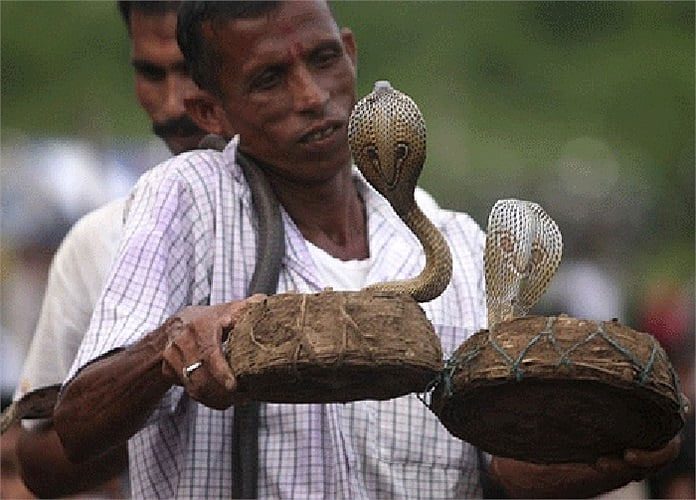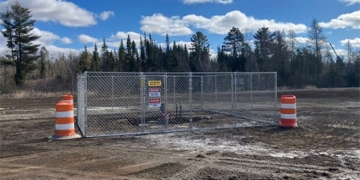A tribe that eats, lives, and sleeps with snakes, even considers venomous snakes as family members. Children are taught to hypnotize from the age of 2 to make extremely venomous cobras gentle and to bond with them.
Questions
Question 1: Which tribe has the ability to hypnotize venomous snakes?
A – Vadi Tribe
B – Sentinel Tribe
C – Konyak Tribe
Question 2: What do the Vadi people do to reduce the danger of snakes?
A – Remove fangs
B – Feed with herbs
C – Cut tails
Question 3: Since what year has hypnotizing snakes been banned in India?
A – 1991
B – 1992
C – 1993

The Vadi Tribe has the ability to hypnotize venomous snakes.
Question 4: After how long do the Vadi people release the snakes they live with?
A – 6 months
B – 7 months
C – 8 months
Question 5: How many people die from snake bites each year?
A – Approximately 138,000
B – Approximately 238,000
C – Approximately 338,000
Question 6: What is the Boomslang snake also known as?
A – South African Green Snake
B – North African Green Snake
C – African Green Snake
Question 7: The Russell’s viper is named after?
A – A shepherd
B – A goatherd
C – A cattle herder
Question 8: How far can a king cobra detect a moving person?
A – 10m
B – 20m
C – 100m
Question 9: How many drops of venom can a Black Mamba kill a person with?
A – 1 drop
B – 2 drops
C – 3 drops
Answers
Question 1: Answer A – Vadi Tribe. Wild, extremely venomous, and aggressive cobras become gentle and bond with humans, even being hypnotized and commanded by them. This is a common sight in Vadi homes – a tribe renowned as the world’s foremost snake enthusiasts, residing in southern Gujarat, India. The Vadi tribe has about 600 people who live nomadically. In this tribe, every child must learn to become a snake hypnotist from the age of 2. Boys learn to perform with their snakes and their flutes, while girls are taught how to care for and nurture them. By the age of 12, these children are expected to know everything about snakes and will “graduate” from their snake hypnotism course.
Question 2: Answer B – Feed with herbs. The Vadi people view the act of removing snakes’ fangs as cruel, so they do not do it. However, to reduce the danger, the snakes involved in the training are fed a type of herb that renders their venom ineffective.
Question 3: Answer A – 1991. Since 1991, the Indian government has banned snake hypnotism, deeming it very dangerous for children and detrimental to the wildlife of snakes. Capturing and training snakes is illegal under Indian law, yet the Vadi tribe is resolutely committed to preserving their traditional customs. The police and authorities regularly check the areas where they live. Therefore, the Vadi tribe never stays in one place for more than 6 months.
Question 4: Answer B – 7 months. Tribe members are very bonded with snakes, especially cobras. They believe that snakes will never harm anyone unless that person intends to hurt them. However, according to Vadi experience, they never keep a snake for more than 7 months. If not released after 7 months, cobras can become very aggressive and pose a danger to humans.
Question 5: Answer A – Approximately 138,000: According to statistics from the World Health Organization (WHO), snakes bite an average of 5.4 million people each year, resulting in approximately 138,000 deaths. What makes snakes terrifying is the neurotoxin produced in their altered saliva glands. They then use their fangs to inject this venom into their victims through bites. Researchers indicate that snake venom has evolved over millions of years to cause severe reactions in victims, ranging from paralysis and tissue necrosis to bleeding leading to death.
Question 6: Answer A: The Boomslang is also known as the South African Green Snake, primarily found in Eswatini, Botswana, Namibia, Mozambique, and Zimbabwe, and is one of the most venomous snakes among those known as rear-fanged snakes. With a head shaped like an egg, oversized eyes, and a body patterned with bright green, the Boomslang is quite striking. According to the South African National Biodiversity Institute, when threatened, Boomslangs will inflate their necks and reveal a patch of brightly colored skin between their scales. Death from a Boomslang bite can be horrific for their prey or victims. Fortunately, there is now an antivenom for Boomslang bites if the victim can access it in time.
Question 7: Answer A – A shepherd: Russell’s viper is a venomous snake found in Asia. It is named after Patrick Russell, a Scottish shepherd who first described many snake species in India. Approximately 58,000 deaths in India are attributed to snake bites each year, and this snake is considered one of the most lethal. The venom of the Russell’s viper can lead to a range of horrific symptoms, including acute kidney failure, severe bleeding, and multiple organ damage.
Question 8: Answer C – 100m. The king cobra (Ophiophagus hannah) is the longest venomous snake in the world, reaching up to 5.4 m. It can detect a moving person from nearly 100 m away. Whenever threatened, the king cobra will use its ribs and a special muscle group in its neck to expand its hood and reveal the bright skin around its head. The fame of the king cobra is not just from the potency of its venom but the amount injected into the victim: each bite delivers about 7 milliliters (approximately 0.24 ounces) of venom, and this snake tends to strike quickly with three or four successive bites. Molecular biologist Sean Carroll at the University of Maryland wrote in The New York Times that even a single bite can kill a human in 15 minutes and an adult elephant in just a few hours.
Question 9: Answer B – 2 drops. Known as the most dangerous snake in Africa, the black mamba (Dendroaspis polylepis) can kill a person with just two drops of venom. Named for the dark ink-like color inside their mouths, black mambas are actually brown. They average about 8 feet (2.5 meters) in length and can move at speeds of 19 km/h. Scientists are uncertain how many people are killed by black mambas each year, but they are responsible for a significant number of snake-related fatalities in southern Africa. These snakes are born with two to three drops of venom in each fang, making them deadly from a young age. According to Kruger National Park, when fully grown, a black mamba can store up to 20 drops of venom in each fang.




















































